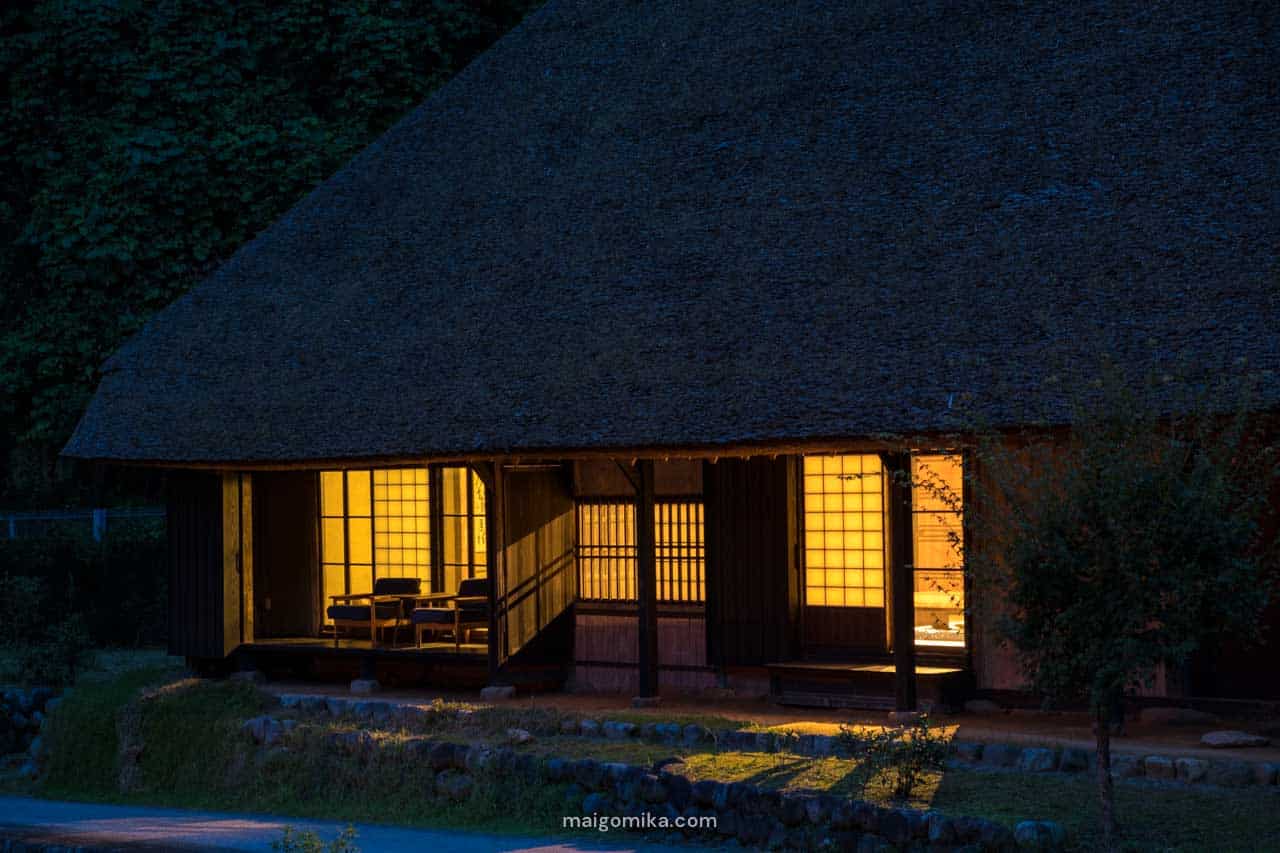Take me from one countryside location in Japan to another, and I promise you that I’ll be stumbling upon some new, never-before-seen natural beauties. That’s one of my favourite things about exploring Japan’s under-represented countryside destinations, where often, the beauty of the landscape and regional architecture make up an area — a “feel” — that is entirely unique. It was that promise, plus the striking and eye-catching cedar roofed folk house of Kominka Shimebaru (古民家 注連原), that had my partner and me making an impromptu booking for this traditional Japanese folk house nestled in Fukuoka’s rural village of Shigebara.
Kominka Shimebaru: A Traditional Japanese Folk house in Fukuoka
Frankly, it didn’t take much convincing for us to choose this charming 150-year-old Japanese folk house for our two-night stay. Catch a glimpse of that dramatic cedar roof facing a river backed by a solid wall of green forest, and it may easily inspire you to do the same. My partner was the one who stumbled onto this folk house while scrolling through AirBnb.com for an inspiring getaway in which to spend my birthday.

After a three-hour drive south from our Oita apartment to Fukuoka prefecture, we arrived in Ukiha city, following narrow country roads up to this lovely, classic Japanese folk house. I’ll bow down to Fukuoka Chikugo Preservation Board (福岡県筑後保健所), who so beautifully restored Kominka Shimebaru to its original architectural glory, with an earth-floored kitchen, earthen walls, and an open ceiling of blackened beams and cedar thatched roof. Of course, we wouldn’t be completely “roughing” it either, with a few modern touches to ensure visitors remain comfortable throughout their stay like the indoor plumbed cedar bathtub, a full kitchen, a bed with down comforters, and if you need it, air conditioning.


Even with its modern conveniences, you won’t get distracted by a TV or WiFi because you simply won’t find those here. Instead, an overnight stay at Kominka Shimebaru is all about absorbing the area’s muted natural sounds, relishing in your friendly company, and falling asleep to the murmuring river and crickets as you lie in the comfy down bed. Or perhaps, like us, it will also come in the form of a glass of sparkling wine with blankets resting over our laps as you sit on the river-facing balcony.




A night at Kominka Shimebaru costs roughly 200.00 CAD (¥20,000) per night — a small price for such a unique experience. You can rent a BBQ at the small restaurant, the same place where we picked up our keys. Our skewered chicken and vegetables over the BBQ coals with the house as our only light source never looked more idyllic.

What else is there to do around Kominka Shimebara?
Aside from a bicycle, walking through the countryside is one of the best ways to really immerse yourself in the beauty of the countryside landscape, and I’ll say the same thing about Shigebara village. Suppose you’re anything like me and enjoy a light excursion. In that case, this village has gentle pathways off the main road that will take you past the neighbourhood thatched houses and ravines to two tourist highlights: Tsuzura terraced rice paddies and the three-thatched Hirakawa Residence.
Tsuzura Terraced Rice Paddies: One of the Top 100 Rice Terraces in Japan
About an hour and 18 minutes walk away are the 400-year-old Tsuzura terraced rice paddies (つづら棚田). Roughly 300 rice paddies occupy over 7-hectare of land, with pathways leading throughout the fields. If we timed our visit later, we would have come just in time for the late September Higanbana festival, where over 500,000 Higanbana spider lilies bloom along the edges of the rice fields. Local farmers typically plant these flowers’ poisonous bulbs to keep digging pests away. However, it’s hard to overlook its aesthetic appeal, an appeal that hasn’t been lost on many who trek to Tsuzura every year with cameras to capture this spectacular sight of lily-lined rice fields.

Even if you miss the Higanbana festival, the wall-to-wall paddy scenery with stone walls leaves plenty to admire to make your journey worth it. Tsuzura has been named one of the Top 100 Rice Terraces in Japan, after all, so you’d be remiss to skip a visit if you find yourself in this region.
It takes approximately 1 hour and 18 mins to walk from Kominka Shimebaru to Tsuzura terraced rice paddies.
The Three-Thatched Japanese Houses of Hirakawa Residence



While you make your way to Tsuzura, it’ll be hard to miss the three-thatched houses of the Hirakawa Residence (平川家住宅) along the way. These interconnected farmhouses were built in the late 18th century, and represent a particular roof type called kudo-zukuri (くど造り), named so for its “U” shape roofline similar to a Kudo, (竈,くど) old-style Japanese cooking range.
These unique buildings are found in Saga, Kumamoto, and southern Fukuoka prefecture of Kyushu, with Hirakawa Residence being one of the finest examples of this regional architectural style. It’s even been designated as National Important Cultural Properties, a rare status given to a private residence like this. You can make advanced indoor tours of the house, but otherwise, you’ll be restricted only to browsing outside the home. These are still private residences, so refrain from visiting in the early morning or after sunset. Maintaining a respectable distance will go a long way to show respect to the current residents.
Give me a weekend, a car, and any excuse to revisit Kominka Shimebaru and Shigebara village, and I’d do it in a heartbeat. For me, that’s one of the biggest appeals of travelling in the Japanese countryside — with a bit of time, a car, and minimal effort, you can easily find your countryside getaway in Japan. What do you think? Would you take the time to visit a place like Kominka Shimebaru? Let me know in the comments below!




